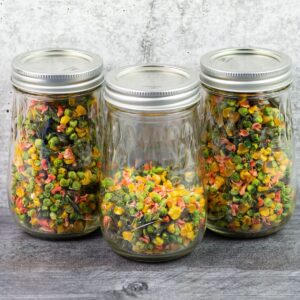
How To Dehydrate Frozen Vegetables
Looking to revolutionize your food storage methods? Discover the secrets of dehydrating frozen vegetables with our invaluable tips that ensure peak flavor and longevity. Whether you're a seasoned pro or a beginner, our guide makes it easy to master the dehydration process—from perfecting preparation to achieving the ideal slice.
Equipment
Ingredients
- 3 large bags frozen mixed vegetables (32 oz bags)
Instructions
Prep
- Choose any type of frozen vegetable. Leafy greens, peas, corn, carrots, and peppers are known to dehydrate well. I am using a basic mixed vegetables that include carrots, corn, green beans and peas.
- Thaw the frozen vegetables.
- Drain the thawed frozen vegetables well in a colander.
Dehydrate the Frozen Mixed Vegetables
- Spread the vegetables evenly on the dehydrator trays.
- Set the dehydrator temperature to 135°F.
- Dehydrate the mixed vegetables for 4 to 8 hours. Drying times will vary.
- Half way through the drying time check for dryness: The vegetables should be brittle or very tough when adequately dried.
- Once the vegetables are done dehydrating allow the dried mixed vegetables to cool to room temperature before transferring them to storage containers.
- Conditioning dehydrated vegetables is a recommended but optional step.
- Place the cooled dried mixed vegetables into airtight containers. Store in a cool dark cabinet for up to a year.
Recipe Expert Tips
- Prior to dehydrating, ensure that all vegetables are defrosted and pat them dry to remove excess moisture. This step is crucial for an even and efficient dehydration process.
- If starting with large cut frozen vegetables cut the vegetables into even, thin slices if needed.
- Once dehydrated, cool the vegetables to room temperature, and store.
- Airtight Containers: Vacuum-sealed bags, jars with oxygen absorbers, or airtight plastic containers work best.
- Cool, Dark Place: Store containers in a pantry or cabinet away from direct sunlight.
- Silica Gel Packets: Consider adding these to containers to absorb any excess moisture.
Nutrition
Serving: 1ServingCalories: 0.01kcalCarbohydrates: 0.003gProtein: 0.001gSodium: 0.01mgPotassium: 0.05mgFiber: 0.001gVitamin A: 1IUVitamin C: 0.002mgCalcium: 0.01mg
Tried this recipe?Share a picture on Instagram and tag @flouronmyface2